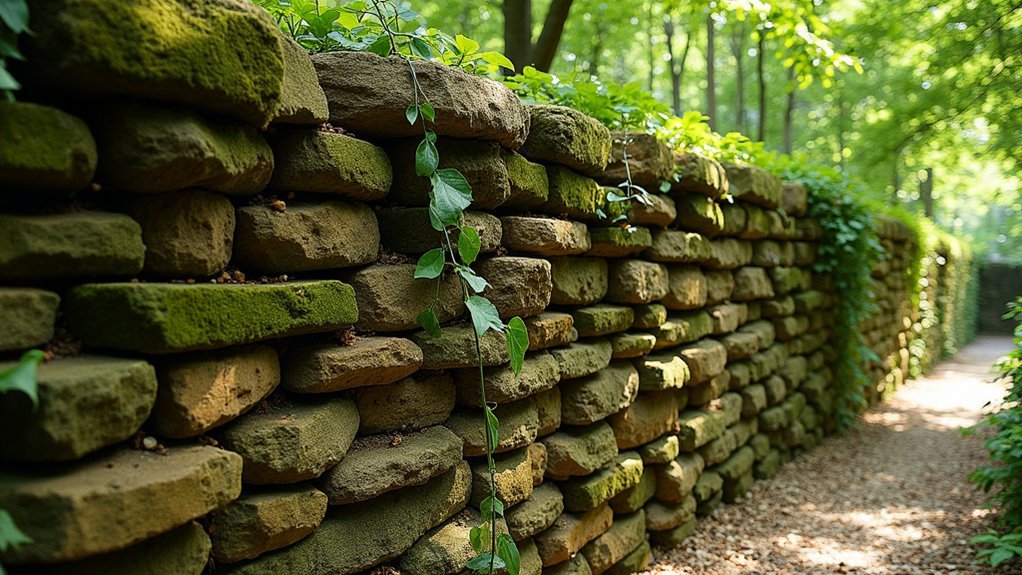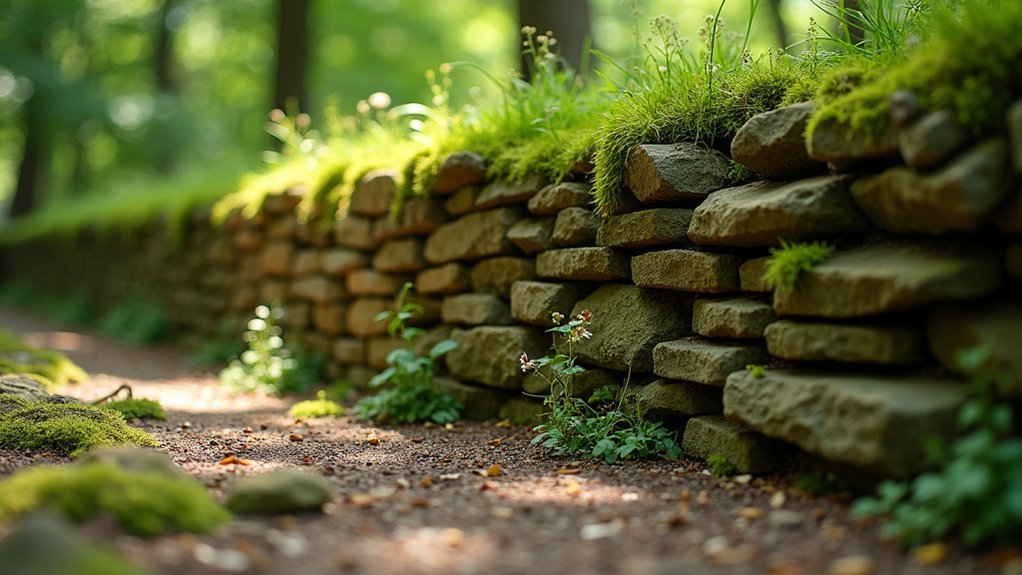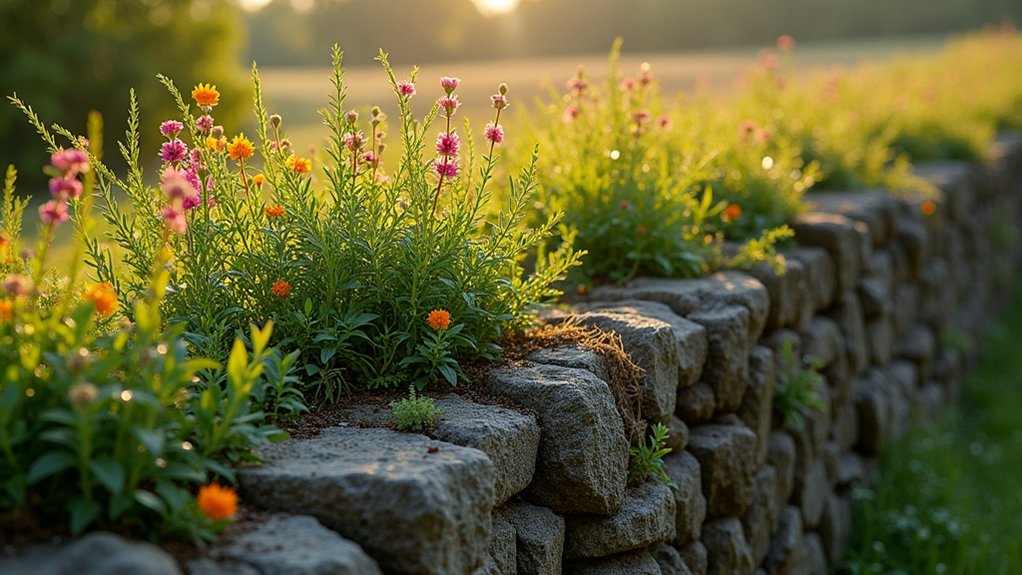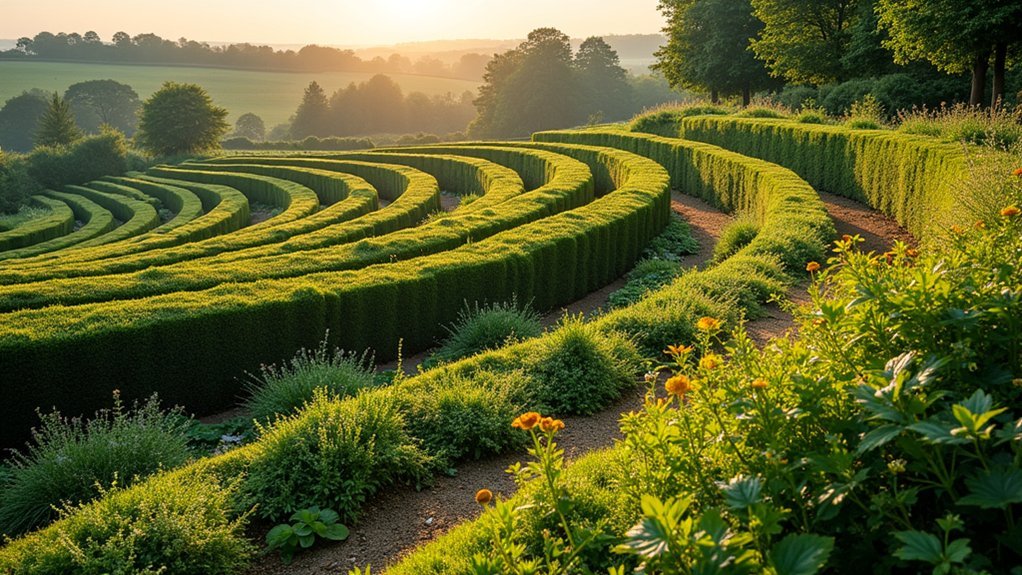Building a historic Devon hedge bank requires careful planning and traditional techniques. First, select a strategic location that respects historical patterns. Gather local materials like stone, soil, and turf. Mark and excavate your site with proper dimensions. Create a solid foundation with compacted soil. Choose between stone or turf facing methods. Allow the bank to stabilize for a full year before planting native species. Maintain regularly by controlling competing vegetation. The following steps will guide you through this ancient craft that enhances biodiversity.
10 Steps to Historic Devon Hedge Bank Formation

Four essential steps form the foundation of authentic Devon hedge bank construction.
First, hire an experienced excavator operator who can achieve the proper profile and compaction needed for long-term stability.
Second, create your bank and ditch using locally sourced materials—either turf- or stone-faced—to complement the surrounding landscape.
Third, allow your newly formed bank to stabilize for at least a year before hedge planting. Avoid using topsoil on the banks as this encourages invasive species that can overtake your intended vegetation.
Finally, select locally adapted plants for your hedge that match old hedgerows in the area, enhancing biodiversity and ensuring better survival rates.
Selecting the Perfect Site for Your Devon Hedge Bank
Several key considerations will determine the success of your Devon hedge bank before you even begin construction.
Look for strategic locations such as gaps in existing hedges, contour slopes, or water course boundaries to maximize biodiversity connectivity.
You’ll want to avoid disrupting established wildlife habitats, deep organic soils, open moorlands, and grazing marshes. Instead, reference historical field patterns to guide your placement, ensuring your hedge bank integrates naturally with the surrounding landscape.
Use materials found onsite for construction—this not only creates a visually cohesive addition but also reduces the risk of draining nearby wetlands.
Plan for at least a 3-meter width for your hedge bank, with wider margins if possible to encourage diverse habitat development and robust growth.
Gathering Traditional Materials and Tools

Many successful Devon hedge banks begin with thoughtful gathering of authentic materials that honor the region’s traditional techniques.
You’ll need to source local stone, soil, and vegetation that match your landscape’s characteristics to guarantee your earth bank remains stable and ecologically sound.
Collect specialized hand tools including spades and forks designed specifically for bank construction, allowing for precise placement and careful building.
Don’t overlook the value of repurposing brash from previous hedge management—these cuttings provide excellent structural support within your bank.
Harvest turf from nearby areas to encourage natural vegetation growth, promoting biodiversity as your hedge bank establishes.
Creating the Foundation: Marking and Excavation
You’ll need to start by carefully marking your hedge bank’s location, respecting historical field patterns while avoiding wildlife habitat disruption.
When excavating, hire an experienced operator who understands proper Devon bank profiles and can achieve the right compaction for long-term stability.
Your foundation should utilize local materials that blend with the surrounding landscape, potentially incorporating turf- or stone-facing techniques that will support biodiversity as the bank establishes.
Layout Planning Essentials
Before breaking ground on your Devon hedge bank, careful planning and precise marking are essential for establishing a robust foundation.
Begin by surveying your site to identify the ideal location, taking note of existing hedge gaps that could be connected to create wildlife corridors. Banked hedges work best when aligned with natural contours and slopes, providing efficient drainage while enhancing the local ecosystem.
Mark your intended layout using stakes and string, ensuring a minimum width of 3 meters to support biodiversity. This clear outline will guide excavation work and help maintain consistent dimensions throughout your hedge bank.
Consider proximity to water courses during layout planning essentials, as this influences both drainage patterns and habitat value.
Remember that proper positioning now will determine your hedge bank’s stability and ecological contribution for decades to come.
Digging Traditional Banks
With your layout clearly marked, the physical creation of your Devon hedge bank begins. Drive stakes at the boundaries and use string to outline straight edges that will support your living hedgerows. The proper width guarantees your new hedges will have stability and ideal growth conditions.
Excavate the bank using a digger or hand spade, creating a wider base that tapers toward the top. This traditional slope prevents erosion and maintains structural integrity. Aim for at least 1 meter in height, considering the natural contours of your landscape.
When building, use local materials like soil and stones, but avoid incorporating topsoil which can encourage invasive species. This approach helps your hedgerows blend naturally with the surrounding environment while establishing a solid foundation for Devon’s distinctive living landscape features.
Building the Core Structure of the Bank

You’ll need to establish solid foundation techniques before adding any plant material to your Devon hedge bank.
Start by layering compacted soil using locally sourced materials that complement your landscape, having an experienced excavator operator guarantee proper profile and density.
If you’re using turf or stone facing, apply it to the exterior while avoiding topsoil that might promote destabilizing invasive growth.
Foundation Techniques First
Three key principles govern successful Devon hedge bank foundations: proper material selection, correct compaction, and appropriate profile shaping.
You’ll want to utilize materials available onsite that complement the local landscape while avoiding disruption to nearby wetland areas.
When establishing your bank foundation, don’t incorporate topsoil, as this encourages invasive species that can undermine structural integrity. Instead, focus on creating a stable base through proper compaction techniques.
For Devon hedges, this foundation must support either turf or stone facing depending on your design choice.
It’s worth hiring an experienced excavator operator who understands the specific requirements of hedge bank formation.
They’ll guarantee your foundation has the correct profile and compaction necessary for long-term stability, allowing natural vegetation to establish on lower banks for enhanced ecological value.
Soil Layering Process
Once your foundation is properly established, the soil layering process becomes the next vital step in creating a robust Devon hedge bank.
You’ll want to use materials available onsite to build a stable core structure that integrates naturally with the surrounding environment.
Ensure you’re achieving the correct profile and compaction as you layer the soil—this is essential for long-term stability.
If possible, have an experienced excavator operator handle this phase.
Don’t incorporate topsoil into your bank, as it encourages invasive species that can undermine structural integrity.
For lower banks, allow natural vegetation to establish itself, supporting local wildlife habitats.
After completing the soil layering process, wait a full year before planting your hedge.
This patience allows your bank to properly settle, providing a strong foundation for your hedgerow.
Layering Techniques for Optimal Stability
Creating a Devon hedge bank that stands the test of time requires meticulous attention to layering techniques and material selection. When layering the hedge, you’ll want to use materials sourced directly from your site to guarantee they blend naturally with the surrounding landscape. Traditional hedges in Devon have thrived for centuries using this approach.
For ideal stability, follow these key steps:
- Bank profile construction – Hire experienced excavator operators who understand proper compaction techniques.
- Facing options – Choose between turf or stone-facing to promote natural vegetation that enhances stability.
- Pre-planting preparation – Allow your bank to settle for one year before introducing native trees and plants.
Remember to avoid topsoil on banks, as this can encourage unwanted species. Instead, plan to incorporate at least five native species for long-term resilience.
Facing Methods: Stone, Turf, or Combined Approaches

When constructing your Devon hedge bank, you’ll need to decide between stone facing for durability, turf facing for ecological benefits, or a strategic combination of both methods.
Stone faces offer superior longevity but require greater initial investment, while turf-faced banks naturally foster local vegetation growth and biodiversity.
You can maximize the strengths of both approaches by implementing a combined method, creating a resilient structure that balances structural integrity with rich habitat potential.
Stone Facing Techniques
Although many techniques exist for Devon hedge bank construction, the facing method you choose greatly impacts both durability and ecological value. When implementing stone-facing for hedge banks, prioritize using stones sourced from your local area to guarantee authenticity and environmental harmony.
For successful stone-facing:
- Proper profile creation – Work with skilled excavator operators to establish the correct angle and base width, preventing future structural failures.
- Strategic stone placement – Position larger stones at the base, graduating to smaller ones as you build upward, guaranteeing maximum stability.
- Thorough compaction – Firmly pack each layer before adding the next to prevent shifting and erosion.
Remember to avoid using topsoil in your stone-faced bank construction as it encourages invasive species that could compromise your hedge’s long-term health.
Turf Layering Essentials
Several well-established turf-facing techniques provide excellent alternatives to stone-facing when constructing Devon hedge banks. When properly executed, turf layering creates a stable structure that naturally integrates with the surrounding landscape.
You’ll need to avoid using topsoil-rich turf to prevent unwanted invasive turf species from dominating your bank. Instead, source materials locally to maintain biosecurity and guarantee your hedge adapts well to existing conditions. This approach supports biodiversity and hedge health long-term.
Consider combining turf with stone facing for maximum durability while maintaining aesthetic appeal. When laying the hedge, remember that proper compaction and profile are essential for stability—trust experienced excavator operators for this critical work.
Allow your bank to stabilize for a year before planting to ensure the best foundation for your living hedge.
Combined Method Advantages
Beyond individual turf or stone techniques, a combined approach offers superior outcomes for your Devon hedge bank construction. By integrating stone-faced banks with turf elements, you’ll create a structure that maximizes both stability and ecological value in your landscape.
The combined method advantages include:
- Enhanced structural integrity – stone provides robust support against erosion while turf binds the materials together.
- Improved biodiversity potential – partial turf-facing creates microhabitats for various plant species and wildlife.
- Balanced resource efficiency – you’ll use fewer stones than a fully stone-faced bank while gaining better longevity than turf-only construction.
When properly compacted and profiled, this hybrid approach creates a resilient hedge bank that’s well-adapted to local conditions, especially when you source materials from your immediate surroundings.
Planting Native Species on Your Established Bank

The successful establishment of native species on your Devon hedge bank requires thoughtful planning and selection. Choose at least five different native species to enhance biodiversity and climate resilience in your hedge.
Consider your soil type and local climate when selecting trees and shrubs, while limiting hawthorn and blackthorn which can be difficult to manage.
Wait a full year before planting to guarantee your bank has stabilized properly. Plant in staggered rows with four to five plants per metre, creating space for future management. Avoid using topsoil which may introduce invasive species.
Once planted, regularly cut back competing vegetation and protect young plants from grazing animals. This maintenance is vital during the early establishment phase, guaranteeing your native hedge thrives for generations to come.
Establishing Wildlife Corridors Through Strategic Design
Creating effective wildlife corridors requires thoughtful placement and design of your Devon hedge banks.
Focus on connecting existing hedges by filling gaps and extending along watercourses to establish continuous pathways for wildlife movement.
When designing your wildlife corridors, consider these key practices:
- Reserve at least 3 meters width for your hedges to encourage diverse growth and maximize habitat potential.
- Select five or more native species for planting to improve resilience against climate change and support local wildlife.
- Implement hedge laying and coppicing techniques regularly to maintain robust boundaries that facilitate species movement.
Avoid planting on existing wildlife habitats, instead prioritizing locations with historical field patterns.
This strategic approach enhances biodiversity while preserving Devon’s distinctive landscape character.
Seasonal Maintenance Practices for New Banks
Once constructed, new Devon hedge banks require careful seasonal attention to guarantee their long-term stability and ecological success.
You’ll need to regularly monitor your bank’s structural integrity, ensuring proper compaction to prevent erosion and collapse.
It’s best to wait a full year before planting on newly constructed banks. This patience allows for proper stabilization and reduces competition from invasive species.
When you do plant, apply locally-sourced wood chip mulch to retain moisture and suppress weeds.
During the growing season, consistently cut back competing vegetation so your newly planted species can access necessary resources.
Avoid using topsoil on banks, as it often introduces unwanted invasive species. Instead, allow native vegetation to establish naturally, supporting the bank’s integrity while creating valuable wildlife habitat.
Frequently Asked Questions
How Have Hedge Bank Construction Techniques Evolved Since Medieval Times?
You’ve seen hedge bank techniques evolve from medieval hand-built stone facings to today’s machine-assisted methods. Materials have diversified, with concrete occasionally replacing stone, while conservation efforts now emphasize traditional approaches for biodiversity.
What Archaeological Evidence Remains of the Earliest Devon Hedge Banks?
You’ll find archaeological evidence of earliest Devon hedge banks in Bronze Age field boundaries, Roman-era earthworks, Saxon estate boundaries, and medieval enclosures. Pollen samples, charcoal remains, and preserved structural elements document their ancient origins.
How Do Devon Hedge Banks Compare to Cornish Hedges?
You’ll notice Devon hedge banks are wider and lower than Cornish hedges. They’re often faced with turf rather than stone, and they don’t typically have the distinctive stone-faced, soil-filled structure of their Cornish counterparts.
Can Historic Hedge Banks Be Dated Accurately?
You can date historic hedge banks through archaeological methods, documentary evidence, and species counting, though it’s not always precise. Radiocarbon dating and pottery fragments also help establish approximate ages when found.
What Role Did Hedge Banks Play in Local Farming Communities?
You’ll find hedge banks were vital to farming communities. They defined your property boundaries, kept livestock contained, sheltered crops from harsh winds, and provided essential habitats for wildlife that supported your agricultural ecosystem.
In Summary
You’ve now mastered the ancient art of Devon hedge bank construction! By following these ten traditional steps, you’ll not only preserve a crucial piece of rural heritage but you’ve also created a thriving ecosystem for local wildlife. Remember, your hedge bank isn’t just a boundary—it’s a living monument that’ll continue to shape Devon’s distinctive landscape for generations to come with proper care.





Leave a Reply